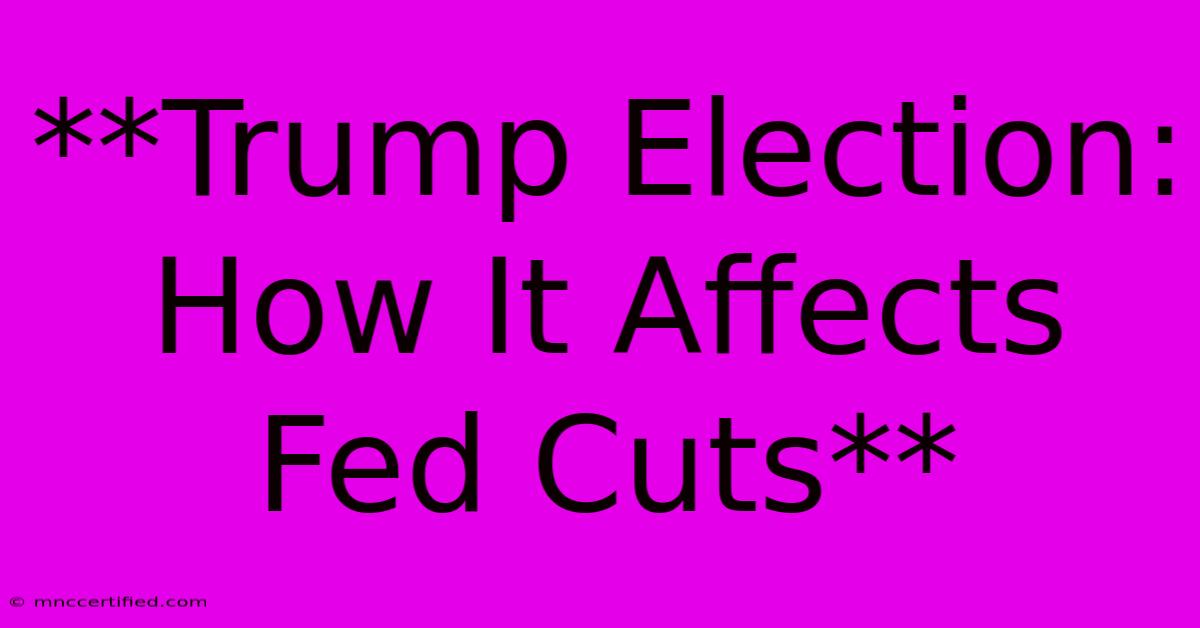**Trump Election: How It Affects Fed Cuts**

Table of Contents
Trump Election: How It Affects Fed Cuts
The 2016 election of Donald Trump as President of the United States had a significant impact on the Federal Reserve's monetary policy, particularly its decisions regarding interest rate cuts. This article will examine the key factors influencing the Fed's actions and the potential ramifications of Trump's policies on the US economy.
The Pre-Trump Landscape: A Time for Caution
Prior to the 2016 election, the Federal Reserve had been cautiously raising interest rates following the 2008 financial crisis. The goal was to gradually normalize monetary policy and avoid overheating the economy. However, the election of Trump, with his promises of tax cuts and deregulation, introduced a significant element of uncertainty.
Trump's Economic Agenda: A Shift in Course
Trump's policies, including tax cuts, deregulation, and trade wars, were seen as potentially boosting economic growth. This, in turn, raised concerns about inflation. However, the impact of these policies on the economy was far from clear.
The Fed's Response: A Balancing Act
The Federal Reserve faced a difficult task in balancing its traditional goals of price stability and maximum employment with the uncertainties surrounding Trump's policies. The Fed's actions were influenced by several key factors:
- Economic Growth: The US economy grew at a healthy pace in the aftermath of Trump's election, which initially led the Fed to maintain its gradual interest rate increases.
- Inflation: Inflation remained stubbornly low, despite Trump's tax cuts and other policies designed to stimulate growth. This allowed the Fed some leeway in keeping interest rates low.
- Uncertainty: The unpredictability of Trump's policies, particularly in trade and foreign affairs, added to the uncertainty surrounding the economy.
The Impact of Fed Cuts: A Mixed Bag
The Federal Reserve ultimately chose to cut interest rates three times in 2019. This was a significant shift from its previous stance of gradual increases. The rationale behind these cuts was twofold:
- Supporting Growth: The Fed hoped that lower interest rates would stimulate economic growth and prevent a recession, which was a growing concern in 2019.
- Counteracting Global Uncertainty: The Fed also aimed to offset the negative impact of global economic uncertainty, particularly the trade war with China, on the US economy.
The Aftermath: An Unclear Picture
The impact of the Fed's cuts on the US economy remains unclear. Some argue that the cuts were necessary to prevent a recession, while others maintain that they were premature and could contribute to future inflation. The economic outlook remains uncertain, with ongoing trade tensions and political uncertainty casting a shadow over the future.
Conclusion: A Complex Relationship
The Trump election had a profound impact on the Federal Reserve's monetary policy, leading to a shift in its approach to interest rates. The Fed's decisions were driven by a complex interplay of factors, including economic growth, inflation, and the uncertainties surrounding Trump's policies. The long-term consequences of these decisions, and the overall impact of Trump's economic policies on the US economy, remain to be seen.

Thank you for visiting our website wich cover about **Trump Election: How It Affects Fed Cuts** . We hope the information provided has been useful to you. Feel free to contact us if you have any questions or need further assistance. See you next time and dont miss to bookmark.
Featured Posts
-
Ashley Jensens Journey After Personal Loss
Nov 08, 2024
-
Tom Hanks Reveals His Celebrity Doppelganger
Nov 08, 2024
-
Westbrook Speaks Out After Thunders First Loss
Nov 08, 2024
-
How Much Does Hrt Cost Without Insurance
Nov 08, 2024
-
West Brom 0 0 Burnley Points Shared In Controversial Match
Nov 08, 2024